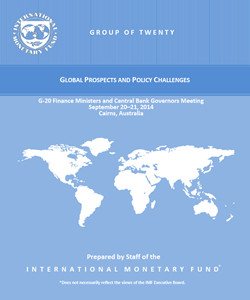Related Links
Group of Twenty IMF Note-- Meetings of G-20 Finance Ministers and Central Bank Governors
IMF Note on Global Prospects and Policy Challenges
September 20-21, 2014
The Following executive summary is from a note by the Staff of the IMF prepared for the September 20-21, 2014 G-20 Meeting in Cairns.
Read the Full text ![]()
Executive Summary
An uneven global recovery continues, despite setbacks this year. Global growth in the first half of 2014 was weaker than expected in the April WEO. Disappointing growth largely reflects a surprisingly soft first quarter in the United States, before negative one-off factors faded and activity picked up in Q2; but also continuing weak performance in Latin America; downward surprises in the euro area, where activity stagnated in the second quarter, and Japan, where output contracted more than expected following the VAT increase; and weaker activity in Russia. In China, after a weaker-than-expected Q1, authorities took policy action to support activity.
Alongside supportive central bank policies, financial conditions have continued easing over the last few months.Sovereign bond yields have edged further down and equity prices have generally risen. Sentiment toward emerging markets has improved, as reflected in resilient portfolio inflows and stable or stronger currencies. Implied volatility measures fell to the very low levels prevailing before the May 2013 tapering remarks. This raises concerns that excessive risk taking may be building up, which could sharply reverse in the run-up to U.S. rate hikes or should geopolitical events trigger higher risk aversion.
Looking forward, the global recovery should regain strength but downside risks have risen. Exceptionally supportive financial conditions, moderating fiscal consolidation, and strengthening balance sheets should support the recovery in the remainder of 2014 and into 2015. Global growth in 2014 would remain below the April WEO forecast, however, reflecting the weaker first part of the year. Downside risks have increased. Heightened geopolitical tensions and a sharp reversal of recent risk spread and volatility compression pose new risks to growth, while other downside risks remain, including those related to U.S. monetary policy normalization challenges, low inflation/deflation in some advanced economies, and, in the medium run, the possibility of growth stagnation more broadly.
Policy priorities are as follows:
- Advanced economies should continue accommodative monetary policies, given still large output gaps and very low inflation. Reflecting the uneven recovery, challenges are becoming increasingly different across major central banks. While monetary policy normalization will be coming to the forefront in the United States, the euro area and Japan have to continue fighting low inflation. To mitigate financial stability risks from a prolonged period of low interest rates and prevent premature monetary tightening, macro-prudential tools should be the first line of defense. The pace and composition of fiscal adjustment should also be better attuned to supporting the recovery and long-term growth.
- In emerging economies, the focus of macroeconomic policies should remain on rebuilding buffers and addressing vulnerabilities, in preparation for an environment characterized by higher interest rates and tighter external financing conditions.
- Decisive structural reforms are needed across G20 economies to boost potential output and help ensure that growth is more sustainable. In a number of surplus countries, the focus should be on boosting domestic demand or modifying its composition. In a number of deficit economies, including euro area countries that switched to surplus recently, structural reform is needed to improve competitiveness.
- Finally, infrastructure investment in economies with clearly identified needs and economic slack, current conditions are favorable for increasing public infrastructure investment. However, while infrastructure investment is needed to support economic development in some economies, efficiency of the investment process and comfortable debt positions to mitigate the potential trade-off between higher output and higher public-debt-to-GDP ratios are important to maximize the growth dividend.
Read the Full text ![]()













